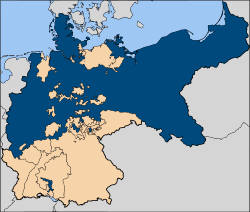Prussian state
| Prussia | ||||||
| Preußen (Preussen) | ||||||
|
||||||
|
||||||
|
Motto Gott mit uns (High German) "God with us" |
||||||
|
Prussia (blue), at its peak, the leading state of the German Empire
|
||||||
| Capital |
Königsberg (1525–1701) Berlin (1701–1947) |
|||||
| Languages | German (official) | |||||
| Religion |
Majority: Protestant (Lutheran and Reformed; since 1817 Prussian United)
Minorities:
|
|||||
| Demonym | Prussian | |||||
| Government | Monarchy (until 1918), Republic | |||||
| Duke1 | ||||||
| • | 1525–1568 | Albert I (first) | ||||
| • | 1688–1701 | Frederick III (last) | ||||
| King1 | ||||||
| • | 1701–1713 | Frederick I (first) | ||||
| • | 1888–1918 | Wilhelm II (last) | ||||
| Prime Minister1, 2 | ||||||
| • | 1918 | Friedrich Ebert (first) | ||||
| • | 1933–1945 | Hermann Göring (last) | ||||
| Historical era | Early modern Europe to Contemporary | |||||
| • | Duchy of Prussia | 10 April 1525 | ||||
| • | Union with Brandenburg | 27 August 1618 | ||||
| • | Kingdom of Prussia | 18 January 1701 | ||||
| • | Free State of Prussia | 9 November 1918 | ||||
| • | Abolition (loss of independence) | 30 January 1934 | ||||
| • | Abolition (de jure) | 25 February 1947 | ||||
| Area | ||||||
| • | 1907 | 348,702 km² (134,635 sq mi) | ||||
| • | 1939 | 297,007 km² (114,675 sq mi) | ||||
| Population | ||||||
| • | 1816 est. | 10,349,0003 | ||||
| • | 1871 est. | 24,689,000 | ||||
| • | 1939 est. | 41,915,040 | ||||
| Density | 141.1 /km² (365.5 /sq mi) | |||||
| Currency |
Reichsthaler German gold mark (1873–1914) German Papiermark (1914–1923) Reichsmark (since 1924) |
|||||
| Today part of |
Germany Poland Russia Lithuania Denmark Belgium Czech Republic Switzerland |
|||||
| 1 The heads of state listed here are the first and last to hold each title over time. For more information, see individual Prussian state articles (links in above History section). 2 The position of Ministerpräsident was introduced in 1792 when Prussia was a Kingdom; the prime ministers shown here are the heads of the Prussian republic. 3 Population estimates: |
||||||
|
History of Brandenburg and Prussia |
|||
|
Northern March pre–12th century |
Old Prussians pre–13th century |
||
|
Margraviate of Brandenburg 1157–1618 (1806) |
Teutonic Order 1224–1525 |
||
|
Duchy of Prussia 1525–1618 |
Royal (Polish) Prussia 1466–1772 |
||
|
Brandenburg-Prussia 1618–1701 |
|||
|
Kingdom in Prussia 1701–1772 |
|||
|
Kingdom of Prussia 1772–1918 |
|||
|
Free State of Prussia 1918–1947 |
Klaipėda Region (Lithuania) 1920–1939 / 1945–present |
||
|
Brandenburg (Germany) 1947–1952 / 1990–present |
Recovered Territories (Poland) 1918/1945–present |
Kaliningrad Oblast (Russia) 1945–present |
|
Prussia (German: ![]() Preußen ; Polish: Prusy) was a historic state originating out of the Duchy of Prussia and the Margraviate of Brandenburg, and centred on the region of Prussia. For centuries, the House of Hohenzollern ruled Prussia, successfully expanding its size by way of an unusually well-organised and effective army. Prussia, with its capital in Königsberg and from 1701 in Berlin, shaped the history of Germany. In 1871, German states united to create the German Empire under Prussian leadership. In November 1918, the monarchies were abolished and the nobility lost its political power during the German Revolution of 1918–19. The Kingdom of Prussia was thus abolished in favour of a republic—the Free State of Prussia, a state of Germany from 1918 until 1933. From 1933, Prussia lost its independence as a result of the Prussian coup, when the Nazi regime was successfully establishing its Gleichschaltung laws in pursuit of a unitary state. With the end of the Nazi regime, the division of Germany into allied-occupation zones and the separation of its territories east of the Oder–Neisse line, which were incorporated into Poland and the Soviet Union, the State of Prussia ceased to exist de facto in 1945. Prussia existed de jure until its formal liquidation by the Allied Control Council Enactment No. 46 of 25 February 1947.
Preußen ; Polish: Prusy) was a historic state originating out of the Duchy of Prussia and the Margraviate of Brandenburg, and centred on the region of Prussia. For centuries, the House of Hohenzollern ruled Prussia, successfully expanding its size by way of an unusually well-organised and effective army. Prussia, with its capital in Königsberg and from 1701 in Berlin, shaped the history of Germany. In 1871, German states united to create the German Empire under Prussian leadership. In November 1918, the monarchies were abolished and the nobility lost its political power during the German Revolution of 1918–19. The Kingdom of Prussia was thus abolished in favour of a republic—the Free State of Prussia, a state of Germany from 1918 until 1933. From 1933, Prussia lost its independence as a result of the Prussian coup, when the Nazi regime was successfully establishing its Gleichschaltung laws in pursuit of a unitary state. With the end of the Nazi regime, the division of Germany into allied-occupation zones and the separation of its territories east of the Oder–Neisse line, which were incorporated into Poland and the Soviet Union, the State of Prussia ceased to exist de facto in 1945. Prussia existed de jure until its formal liquidation by the Allied Control Council Enactment No. 46 of 25 February 1947.
...
Wikipedia





